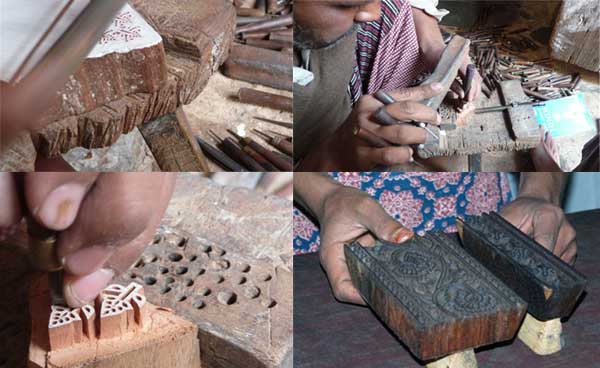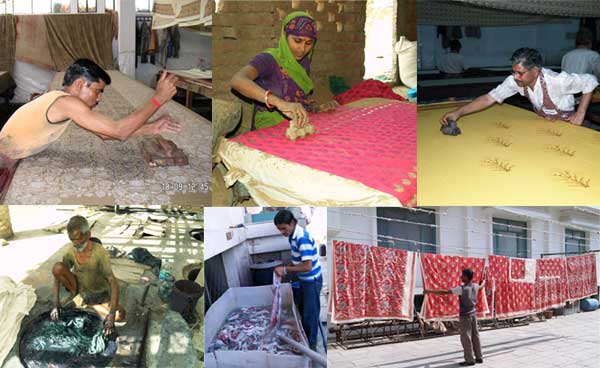
History of manual printing with a pad or wood blockThe origins
It is difficult to date the beginning of the use of the pad printing technique. According to recent discoveries, it could go back 5,000 years. In tombs in Upper Egypt, pieces of printed cloth have been uncovered, others in the ruins of Mohenjo Daro, an ancient city in the Indus Valley. Dated to 2100 BC, the murals found in Beni Hassan depict Afro-Asians dressed in costumes with striped or zigzag patterns. Were they imprinted using stone or woodblock prints? However, the discovery in Akhrnim in Egypt of blocks engraved with figures and that of patterns on textiles, as well as a fragment of printed cotton found in Arles, attest with certainty to the use of the wood pad printing method. in 542 BC
Development in EuropeFrom the 11th to the 14th century, the Germans printed textiles with a wooden pad, trying to imitate, very poorly, the refinement of the woven patterns of the Byzantines or Italian silks. With prosperity, this wood pad printing technique was neglected in favor of richer processes: weaving or embroidery.
Thanks to the contribution and the inspiration of India, Augsburg made itself famous, in the XVIIth century, for its factories of prints on linen. It was through export that the printing of colored patterns spread again: in France from Alsace, in Switzerland and in England. Workshops flourished in Europe until the 18th century. Development in IndiaThis art of printing flourished in India in the 12th century, under the patronage of the Rajas. And it was in the 16th century that “les Indiennes” (block printed cotton) were exported from Pujab and Bombay to Europe by Dutch merchants! The 17th century saw a period of revitalization of the process, but it was truly in the 18th century that India left us the most beautiful proofs of its mastery of the technique of wood pad printing and testimonies of its sophistication: through canopies, wall hangings, bedspreads, coats and other pieces of clothing. The variety of textile supports, patterns and color palettes were specific to different regions, and the development of workshops mainly related to water, necessary for steaming and final washing. Competed in the 19th century by European manufacturers, this art, which remained alive on the local market, has declined, in favor of other methods, such as the block printing machine or screen printing. Today the main center of wood pad printing is in Rajasthan, in Sanganer - Jaipur where some workshops are very active on the local market as well as for export. Sanganer was recognized recently (end of 2009) as a Geographic Source for 500 years of the craft of manual printing to wood block. It is a kind of global AOC that protects the process. |
 |
| Printing technique using wood block or pad The beauty of the printed textile pieces - fineness of the design, regularity of the "stamp", harmony and chromatic richness, reliability of the colors in washing and of course creativity - require the skills of craftsmen with very different specialties, which few workshops bring together. Manufacture of the wood stamp:The motif is first created on paper, and the distribution of colors decided. For polychrome designs, 4 to 20 stamps may be necessary depending on the complexity of the design and the richness of the color range. The engraving of a single stamp can occupy five sculptors for three days. On the perfectly flattened and sanded piece of teak, the design is carried over. The parts intended for the relief are colored in order to easily distinguish them from the spaces to be hollowed out. The sculpture is done gradually, the general masses are first roughened up to the finest details. The carving of the outline blocks of a drawing is particularly delicate. There will be as many engraved wooden blocks as there are colors. Many shapes and sizes can be nested, so each block is engraved with markers that will allow good continuity from design to printing. The wood buffer thus obtained is soaked in oil for two weeks in order to nourish the wood sufficiently so that no cracking spoils it and allows better adhesion of the stain. On the back part of the block, a wooden handle is added allowing the artisan printer to hold it.
Printing process:
It is the "master of colors" who prepares the palettes. On small rolling tables, are placed each pallet composed of a wooden box, filled with a "thousand sheets" of jute, on which the colored dough is poured in a studied quantity. The colors are produced one after the other as the printing work progresses, from pigments, often chemical nowadays, sometimes natural such as indigo. Artisan printers work on long tables, which they cover with a "mattress" of about twenty layers of jute, wool or cotton tightly stretched. This surface obtained, neither too soft nor too rigid, provides an ideal basis for the application of printing pads. The fabric to be printed (mainly cotton, but also linen or silk), is adjusted on this mattress and held by pins. The craftsman prints his wooden stamp on the colored palette and applies it to the virgin fabric, then with the other hand, "hits" it. Then he uses the marks to print following or with another stamp to complete the pattern. One color is usually printed on the entire piece of fabric, often with multiple stamps with different designs. After the fabric has dried, it is stretched again on the table and printed with another color, usually by another printer. The process, carried out as a team, is repeated until the final textile is obtained. The fully printed and dried piece is finally treated to fix the colors: wrapped between cloths or paper, the fabric is steamed, then washed again, sun dried and ironed. |
 |
All stages of wood pad printing and final treatment help to set the pigments, guaranteeing richness and good color retention.
During the monsoon, given the heavy rains and the high ambient humidity, drying becomes much longer and production is generally slowed down.
The more complex the piece of fabric is in patterns, colors or both, the more blocks and manipulations it requires, the more expensive it will be! |
How to Create a Cozy Boho Home This Winter with Hand Block Prints
December 19th, 2025Why Hand Block Printed Patchwork Tote Bags Are the New Everyday Essential
December 12th, 2025How to Wash and Care for Block Printed Fabrics the Right Way
November 25th, 2025